A surf trip, driving overland, through Central America had been my dream for as long as I can remember. Probably since I started surfing, just after I moved to Costa Rica – now more than twelve years ago. I had the whole thing planned. I’d buy a car in California, find a dog to keep me company, and hit the open road on my own. Chasing those sweet southern swells to my insatiable soul-surfing heart’s content, camping on the beach along the way, and staying gone as long as I wanted – or at least until I ran out of cash. Whichever came first. I was 20 years old, hell-bent on hedonistic freedom, single as the day I was born and crazy enough to actually do it.
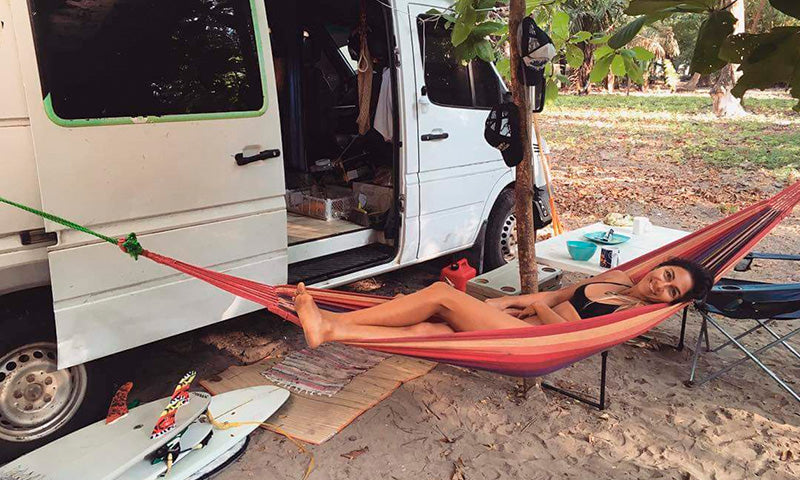
But as life would have it, more than a decade would pass before the stars aligned and all the pieces fell into place. And in the process, plans changed a little to fit my current life circumstances. There would be no dog. Pedro, my Venezuelan surfer-babe boyfriend, would be sitting shotgun as surf-partner-in-crime, personal security guard, self-appointed DJ and co-pilot with a mind for engine mechanics. We’d make the trip backwards, from Costa Rica north to California. In our badass converted 2004 Dodge Sprinter van, complete with solar panels, a big comfy mattress, and all the camping gear we would need. And as for staying gone as long as I wanted? Well, with real-life commitments of a thirty-something year-old surfer girl on the hustle to make ends meet while living dreams of my own design, a month on the road would just have to do.
We were woman and man with a van and that no-plan kinda plan.
Chasing dreams from south to north, we found waves, worries and wonder nearly every step of the way – as any great adventure would have it. After unfortunate visa hassles for Pedro and success bribing the van through customs at our first border crossing, I started the journey on my own, sleeping with a knife under my pillow in the otherwise empty parking lot of the immigration offices on the Nicaraguan side of the border. In the morning, I connected with surf sisters sprinkled serendipitously in both north and south Nicaragua. Blessed by their generosity, fold-out futons, strawberry donuts and safe parking lots, I found space to rest my head, sisters to hold my hand, and epic Nicaraguan off-shores at the tail-end of an early-season south swell. Among perfectly peaky waves and inspiring surfing women, I was grateful for the blessings in such an unexpected start to the trip.
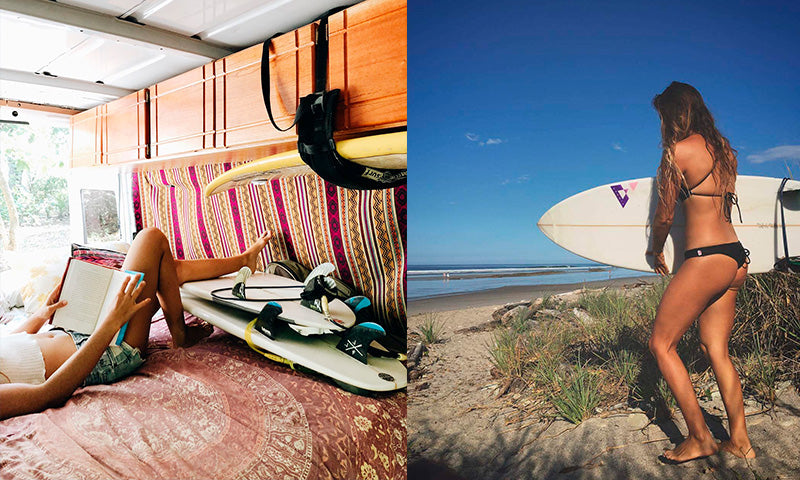
Pedro and I would link back up in eastern El Salvador, but first I would cross the scariest borders in Central America in the van, alone. Quite the anomaly in countries where sexual assault, domestic violence and rape statistics are staggering.
‘Are you traveling alone?’ they asked me at 17 military check-points in three countries where well-armed men in uniform stepped filthy boots up into the van to search for contraband, look at my legs, ask for my phone number, and safeguard against other serious threats to national security.
‘I’m fine,’ I’d tell myself out loud each time I neared an armed checkpoint. ‘I’m doing great. I’m almost there. The van is safe. I am safe.’ Some days, affirmations are more like Prozac than prayer.
Entering El Salvador felt like a breath of fresh air in a place I knew as familiar. I scarfed a few pupusas and drove the windy, bumpy road to Las Flores. Despite the country’s heavy history of deadly civil wars and ongoing gang violence centered around urban areas, the eastern countryside feels mellow, and the locals reassure you that tourists aren’t targets for violent crime. They also suggest you keep your things locked up safe in the cement, bunker-like cabinas with bars on the windows, and that you never walk the beach after sunset. And while the locals are generally friendly and welcoming, there’s a tangible, understandable heaviness in the air, and a lot of male eyes on your skin as a woman walking the earth. The shorts I wear at home have no place in El Salvador, unless I’m willing to stomach the incessant stares right up on in there. That one, I unfortunately learned the hard way. The pussy-peepers, I call them, are ruthless in their resolve, infiltrating the soul-space of even the most tenacious feminists among us.
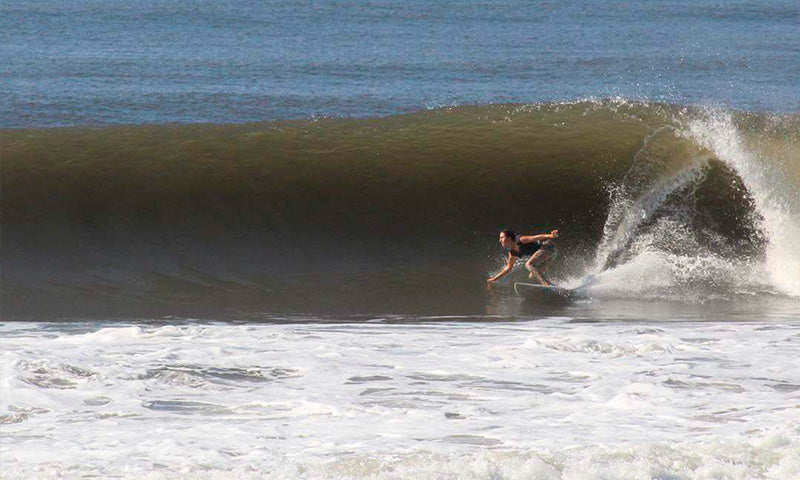
When I arrived to Las Flores, we were between swells and the waves had fallen flat. Pedro climbed into the van well after midnight, following a late flight and a long taxi ride. We savored a slow morning, checked the surf to no avail, and decided to get moving north to Guatemala. We’d make tracks to catch the swell in southern Mexico. After all, we only had three weeks left to make it all the way up to California.
The next morning an armed guard tapped the butt of his rifle on our window, asking us kindly to move the van so a cement truck could pass through the gates of the drive-thru zoo where we had stopped for a few hours’ sleep, halfway across Guatemala. As the day drifted with the reggae tunes of our road trip soundtrack, I reflected on the resentment in the bittersweet sense of gratitude I felt for my man’s presence by my side. The injustice of all the things I could do and all the places I could go, simply because I was no longer a woman travelling alone. The Western feminist in me couldn’t stand the fact that my freedom was still in so many ways contingent on the attitudes and actions of men – be they perpetrators, predators, partners or protectors. I write and fight and pray for the day that women everywhere can walk the world without changing our behavior to accommodate the presence of men, in any of their manifestations.
After hours in Semana Santa traffic (read: Latin America’s holy week before Easter, when everyone and their moms head to the beach) along the memorably bad, two-lane roads of the Pan-American Highway, and longer hours begging and pleading with the Mexican customs agents to accept our less-than adequate vehicle documents, we finally made it to Tapachula – a bustling Mexican border city just a few miles from the beach. We camped in the parking lot of a well-guarded hotel and showered in the sink of the shared lobby bathroom.
Street tacos never tasted so good.
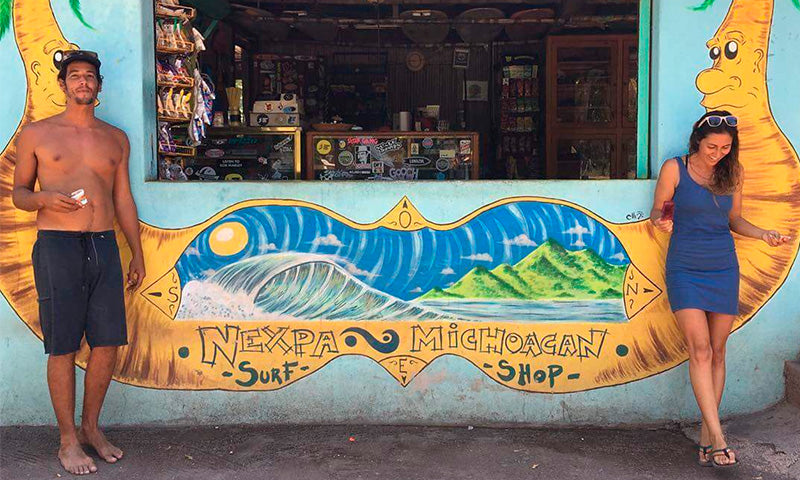
As the swell began filling in, we traversed Chiapas and made our way into Oaxaca, mainland Mexico’s surfing mecca. We drove through the desert salt-lands of Salina Cruz, where visiting surfers are required to hire a local surf guide to access the community-managed waves. We parked the van to take a look before a salty local vibed us the wrong way and we decided to hit the road rather than pay to play. Luckily, Barra de la Cruz was just around the corner, welcoming us with open arms and chest-high waves on a dropping tide before sunset. We watched the sun dip behind the iconic boulders and cactus-covered cliffs, as the full moon rose out of the horizon above the sea. We chatted to an Australian couple who had been traveling to Barra to surf every season for the past 18 years, well before Rip Curl’s infamous Pro Search Somewhere in Mexico contest that put the spot on the map when it was still an unexploited wave with no international name. Our morning surf was as crowded as it gets, but locals were friendly and beginners stayed mostly down the line. I slid into a bunch of punchy, slow-rolling beauties, connecting turns all the way in towards the shore. After days of travel, all the uncertainties at Central American borders and strange homes for sleepless nights, the sea was the exhale I could finally settle into, digging my fins into the real start of the surf trip I had dreamed of for more than a decade. We had made it to Mexico.
At night we ventured out for fish tacos, sipped Coronas to the crooning rancheras blaring to the beat of the neon lights from the karaoke machine in the corner, and fell absolutely in love with all things Mexico. Quite unlike my Spring Break days with the girls in Cabo San Lucas when I was 18 and more than borderline alcoholic, that Corona was the only drink I’d had in five months and counting. I imagine this surf trip would have looked a hell of a lot different had I actually done it twelve years ago, at the height of my hedonistic party all night, wanna-be surfer girl lifestyle, and not now, as I was nearing 33 and living nearly 100% substance-free.
Further north, I played surfer’s girlfriend and photographer at the heavy barreling beach break at Playa Zicatela in Puerto Escondido, quite content to not be surfing there, while admittedly not at all stoked on the general debauchery in town on the busiest party weekend of the year. Soon enough, we traded the hustle-bustle of surf-city-by-the-sea for an off-the-beaten path sort of spot deep in a national park. On the dropping tide, we’d paddle across the river and beyond the adjacent jetty, as the ocean drew us out perfectly toward the peak. In the late afternoon, the sun set golden fire beyond the grass-thatched huts and tall palm trees. After endless hours in the sea, we bathed with a bucket of borrowed water and a hollowed-out half of a coconut – our private lovebird-bath beside the river. We watched the waning moon rise ceremoniously, glowing stoic between the cloud lines among an entire universe of stars. Our van-life neighbors, European and South American hippy-hearted souls, sang songs and played music in the early evening, with no other sounds in sight. We slept peacefully to the steady hum of the sea and made quiet love at sunrise as the waves thunder-crashed against the rocky headland. There in the van in a strange and beautiful land at the edge of the earth, we were more at home than we had felt in weeks.
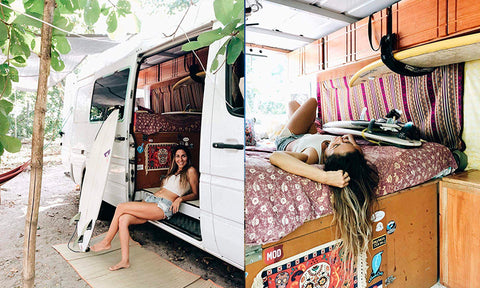
As we continued northward, the swell picked up again on our second day in Nexpa, a surfy van-life safe haven where we camped by the river and hung the hammock between the palm trees. We had a fun morning session out at the point and I stretched into my yoga practice on a run-down cement platform with a mermaid painted on it, in the late-afternoon light beside the van. It was an idyllic surf paradise, with only a few restaurants and cabinas lining the beach, and van life neighbors whose stories and sensibilities paralleled our own mellow melodramas in search of warm sunshine and peeling offshore waves. I could have stayed a lifetime.
We got held up in La Ticla, where indigenous communities had set a three-day road block, demanding justice for their people when the government had heeded them no mind following the violent death of a local woman. What would eventually be a victory for the communities meant long hours waiting for safe passage for us. Luckily, we scored powerful head-high waves, shared some killer fish tacos with friends who just happened to be passing through, and learned about La Ticla’s unique surf tourism management model, where coastal lands are designated indigenous reservation and foreigners cannot live, own land, work, or run businesses. I reveled in knowing that La Ticla could be one of the few places on Earth where surf tourism didn’t mean selling out, and where wave-hungry foreigners could never colonize coastal lands for longer than a few weeks at a time.
Pedro’s barreling birthday beach break was a not-so-secret spot that shall still however remain unnamed, where we parked the van beside a beachfront restaurant run by hospitable cross-dressers with a habit for late-night dance parties in their underwear. I settled into my role as surf photographer with a little more joy this time, soaking in the crisp mornings and those first rays of sunlight warming the skin on my shoulders and the sand beneath my sarong. It was barrels for breakfast, van-made avocado tacos for lunch and afternoons spent organizing ourselves for the long trip ahead. As we waited out the swell that never delivered as we hoped it would, I watched my man in his element, loving every second of the heavy waves I was happy to have seen and not surfed. While I carried the history of my formative beach break girl in my self-compassionate heart, that addictive part of my surfing story was slowly transitioning into the past. Something significant had changed in me over the last few years of my surfing life, as I found myself no longer finding any joy in suffering for my waves in heavy conditions.
I believe there’s a shift that happens, sooner or later, in the life of every wild, wanderlust woman. Where the sorts of adventures we seek transition from high-adrenaline, danger around every curve, needing to taste the threat of death in order to feel alive kind of experiences, to the more everyday adventures, where we play around the edges of our comfort zone, yet no longer find fun in the hassles of extremely consequential risks gone wrong. Maybe it’s maternal-instinctual. Maybe our adrenals are so shot that we literally can’t take anymore. Maybe it’s just a part of growing up. Whatever the cause, it comes with a practiced maturity in knowing our own limits, even if only because we’ve gone a little too far a few too many times. And it comes with integrating life’s many lessons, even if we’re meant to learn them the hard way, sometimes. And as surfers, I believe that shift is self-definitive of who we are as women walking the world, chasing the waves that bring us joy and lead us on dream-inspired journeys we couldn’t plan for if we tried, empowering us to step up and into our sturdy foundation of self-love and creative expression as we wander, wise enough now to know the difference between dreams and just plain dumb. This trip, chasing waves through Central America, was the moment I recognized that subtle, fundamental shift in me.
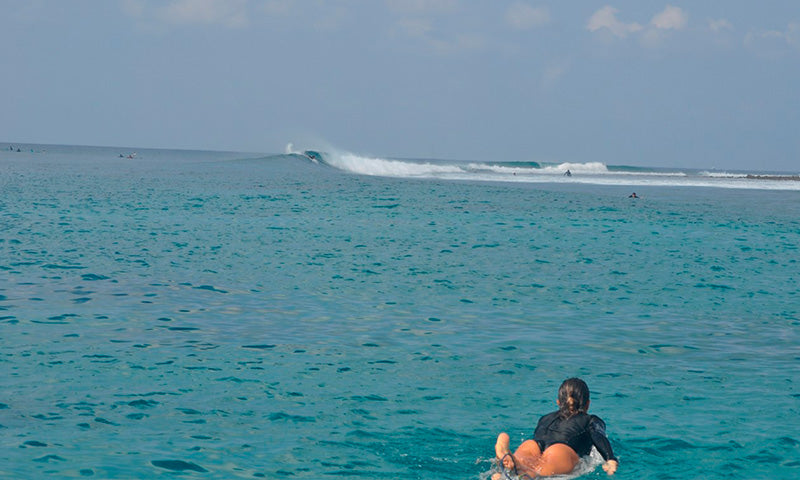
Over the course of four long days en route to the US border, life would throw us a range of curveballs we could have never expected. First, our alternator died, and we had to wait three days for a replacement part, camped out in front of the mechanic shop in the middle of Magdalena, Jalisco. 300 miles later, we broke down again, this time in the black of night with no emergency lights, on a bridge of a two-lane highway with semi-trucks passing at exorbitant speeds, just outside Rosario de Sinaloa, the scariest cartel stronghold in all of Mexico. Digging deep into our well stream of resilience, we got towed to the toll station where we’d spend the night in the van on the highway, and wake up in the morning to watch women of the night climb in and out of the passenger side of the big trucks just passing through. While we waited to meet the mechanic and get back on the road, vulnerability found new meaning in my conscience as I imagined what a life like that must be like, and how strange it was to be sharing space with women whose worlds were otherwise so far from my own.
Crossing the border into Arizona, overland, from Mexico was an admittedly welcome sigh of relief. I photographed the wall stretching in either direction as far as the eye could see, contemplating the costs of security, dreams and freedom among all those superficial lines drawn in the sand.
Tired in our bones. Grateful in our hearts. Under the wire and in the space of adventure where dreams became real, we arrived to California the very next day, after stopping for a night in Tucson and celebrating a well-earned sunset over the cliffs in San Diego. We made it to Los Angeles just before midnight - both our final destination and immediate place of departure just 24 hours later, as we continued our adventure across the seas, two wanderlust warriors living the journey of life the best and only way we know how.
Writen by Tara Ruttenberg. Van pictures by Taya Photography/ @tayaphotography.
Tara is a writer, surfer, yoga teacher and graduate student of sustainable surfing tourism based in Santa Teresa, Costa Rica. She created Tarantula Surf as a space to share her stories and engage with alternative social paradigms. You can read more of her work at www.tarantulasurf.com and connect with Tara on social media: @tarantulasurf.


